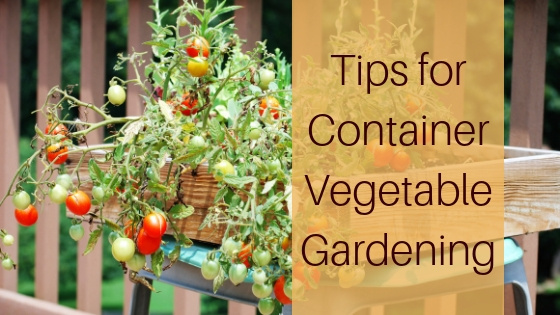Tips for Container Vegetable Gardening
Summer has many exciting sights, sounds, and tastes. For many people, these unique pleasures of summer revolve around fresh fruits and vegetables that they grow themselves. Unfortunately, many people live in small apartments, condominiums, or patio homes and don’t have the luxury of large plots of land to garden and cultivate. That is where the practice and convenience of container vegetable gardening comes in.
With container vegetable gardening, anyone can enjoy the tastes and smells of the summer. As long as you take care to choose the proper containers, give adequate light, and prepare the proper soils, spacing and drainage, a lack of gardening space is no longer a problem.
Container Vegetable Gardening Basics – How to Chose a Container
Containers can be made of many materials. Store bought pots or gardening boxes are often made of clay or plastic. At the store, you will find many container options available to you. As a general rule, for container vegetable gardening, you want to ensure that your container has a diameter of at least 6 inches and a depth of 8 inches. This size will suit most small, shallow rooted plants including most herbs, lettuce, or peppers. Larger plants, such as tomatoes and cucumbers, will require a larger container. Half-barrels, wooden tubs, or large pots are perfect for the larger plants.
Learn more about gardening pots here
You can build homemade boxes out of wood, or even recycle items such as 3-liter pop bottle bottoms, milk jugs, or plastic bowls. The key to a recycled container is to pay attention to the size of the container. Consider the same size requirements for home-made containers that you would for store-bought containers.
Regardless if your container is store-bought or recycled, you want to ensure proper drainage. Container vegetable gardening requires more frequent watering than traditional gardening. If your soil and container do not allow for drainage, your vegetables will not flourish. If you are using a home-made container, drill or punch holes in the bottom. Also, if your container is sitting on a flat surface, it will block drainage as well. It is best to elevate gardening containers.
Container Vegetable Gardening Basics – How to Prepare Soil
 While you might get by with plain “dirt” in your gardening containers, you will have better results with a synthetic gardening mix. The synthetic peat or loam based mixes that contain vermiculite provide better drainage, hydration, and oxygenation. With container vegetable gardening, soil conditions are important because the root system will be restrained within the walls of container. If a soil is not prepared correctly, you can suffer root rot or root compaction.
While you might get by with plain “dirt” in your gardening containers, you will have better results with a synthetic gardening mix. The synthetic peat or loam based mixes that contain vermiculite provide better drainage, hydration, and oxygenation. With container vegetable gardening, soil conditions are important because the root system will be restrained within the walls of container. If a soil is not prepared correctly, you can suffer root rot or root compaction.
Learn all about soil here
You should also consider fertilizer for your plants. A single application of a slow release fertilizer, or a more active schedule of a traditional fertilizer, will ensure your plants stay fed throughout the season.
Learn more about fertilizer here
Container Vegetable Gardening Basics – How to Choose Crops
While any vegetable might grow in a pot, you will have better luck with the bush or dwarf varieties. Also, vegetables with a small foot print such as carrots or radishes are also well suited for container vegetable gardening. Regardless of the vegetable you choose, pay attention to the sunlight, temperature, and season recommendations that accompany the plant or seed.
Here are some specific vegetables that are do well in container vegetable gardens:
![]() Cucumbers
Cucumbers- Green Beans
- Green Onions
- Herbs (nearly all varieties)
- Leaf Lettuce or spinach
- Lima Beans
- Peppers
- Pole Beans
- Radishes
- Tomatoes
Container vegetable gardening is a fantastic way for anyone, anywhere to produce summer vegetables, fruits, and herbs. As long as you pay attention to container size and plant choice, and you consider the special soil conditions and drainage necessary for container vegetable gardening, you can have a flourishing garden in no time.
Here is a great way to recycle your water and soda bottles to grow food, even if you live in an apartment.
 2-liter bottle recycled garden container
2-liter bottle recycled garden container
1. Cut plastic bottle in half.
2. Turn upper bottle half upside down.
3. Insert cotton cloth remnant into spout, leaving half inside bottle and
half out, to serve as a wick.
4. fill lower half of bottle with water.
5. place upside down upper bottle half into lower bottle half.
(Cotton remnant will wick up water.)
6. fill upside down upper bottle with soil and plant seeds or seedling.
(TIP: Using different colored cotton remnants will add color to your recycled bottle garden.)




 Cucumbers
Cucumbers